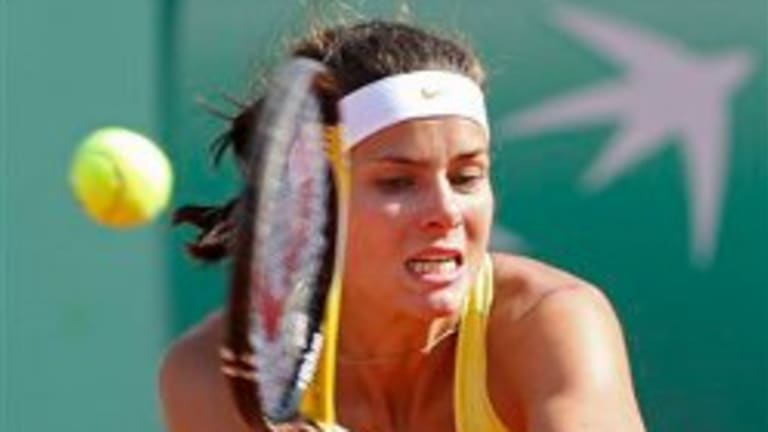Julia Goerges, a dark horse pick for the women’s title this year, survived rather than convinced in a 2-6, 7-5, 6-2 win over Lucie Safarova. Asked earlier in the week how she would rate her chances for the title, Goerges noted that it was a little premature to discuss when she had never before reached the second week of a major. Handed a tough draw in facing Safarova, a dangerous floater who once beat Amelie Mauresmo in the third round of Roland Garros, it looked as if her warning might have been well taken.
Both women play with such extreme aggression that the match was a race to hit winners rather than clay-court tennis in any traditional sense, and for the first set-and-a-half Safarova was winning that race comfortably, breaking Goerges twice to lead 6-2 and going a break up in the second. Much of Goerges’ burgeoning reputation has been built on her consecutive defeats of Caroline Wozniacki during the clay-court season, but watching her constantly go for winners that weren’t there and making a bushel of unforced errors suggested that, faced with a player whose game is as aggressive as hers, she had little idea how to respond.
Safarova’s game, like fellow Czech lefty Petra Kvitova, is built on using her serve to open up the court and smacking away winners. She has, however, almost no defensive capabilities, leaving her quite vulnerable. What set Goerges apart today was her willingness to modify a losing tactic; a simple decision in the second set to play with more patience and stay in the rallies longer was all the encouragement Safarova needed to fall apart.
Waiting for the right moment to unleash her forehand and frequently deploying the drop shot to exploit Safarova’s awkward movement were both good strategic moves by Goerges, who got the break back at 4-4, but a little more mental fortitude on Safarova’s part would have rendered both ineffectual. As it was, she only underlined her status as a player who doesn’t require much to implode; she was broken to lose the second set and gave up her serve immediately in the third. The decider was marked by a general and fatal lack of steadiness; Safarova earned break points with spectacular attacking returns, then squandered them by lame errors on the same shots. She continued to make more first serves than Goerges, but was unable to hit aces and unreturnables at key moments. Dragged into net on Goerges’ second match point, Safarova barely even moved her racquet as the winning cross-court backhand whistled past her.
It’s good to see Goerges mixing it up, to the extent she’s capable of doing that, and thinking on her feet during a match; she survived the Safarova firestorm and keeps her hopes alive. Still, the story of this match was Safarova’s inability to win it.
—Hannah Wilks
